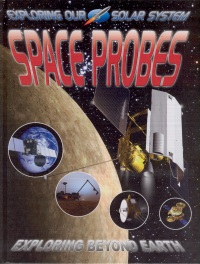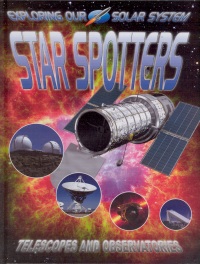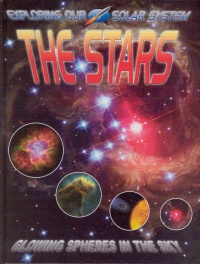| ________________
CM . . .
. Volume XV Number 18. . . .May 1, 2009 
 |
Galaxies: Immense Star Islands. (Exploring Our Solar System).
David Jefferis.
St. Catharines, ON: Crabtree, 2009.
32 pp., pbk. & hc., $9.95 (pbk.), $20.76 (hc.).
ISBN 978-0-7787-3740-7 (pbk.), ISBN 978-0-7787-3723-0 (RLB).
Subject Headings:
Galaxies-Juvenile literature.
Milky Way-Juvenile literature.
Grades 3-6 / Ages 8-11.
Review by Jane Bridle.
**½ /4
|
| |
|
 |
Space Probes: Exploring Beyond Earth. (Exploring Our Solar System).
David Jefferis.
St. Catharines, ON: Crabtree, 2009.
32 pp., pbk. & hc., $9.95 (pbk.), $20.76 (hc.).
ISBN 978-0-7787-3741-4 (pbk.), ISBN 978-0-7787-3724-7 (RLB).
Subject Heading:
Space probes-Juvenile literature.
Grades 3-6 / Ages 8-11.
Review by Jane Bridle.
**½ /4
|
| |
|
 |
Star Spotters: Telescopes and Observatories. (Exploring Our Solar System).
David Jefferis.
St. Catharines, ON: Crabtree, 2009.
32 pp., pbk. & hc., $9.95 (pbk.), $20.76 (hc.).
ISBN 978-0-7787-3742-1 (pbk.), ISBN 978-0-7787-3725-4 (RLB).
Subject Headings:
Astronomical observatories-Juvenile literature.
Telescopes-Juvenile literature.
Radio astronomy-Juvenile literature.
X-ray astronomy-Juvenile literature.
Grades 3-6 / Ages 8-11.
Review by Jane Bridle.
**½ /4
|
| |
|
 |
The Stars: Glowing Spheres in the Sky. (Exploring Our Solar System).
David Jefferis.
St. Catharines, ON: Crabtree, 2009.
32 pp., pbk. & hc., $9.95 (pbk.), $20.76 (hc.).
ISBN 978-0-7787-3743-8 (pbk.), ISBN 978-0-7787-3726-1 (RLB).
Subject Heading:
Stars-Juvenile literature.
Grades 3-6 / Ages 8-11.
Review by Jane Bridle.
**½ /4
|
| |
|

excerpt:
Black Holes are incredibly dense points of matter, whose super-strong gravity prevents even light from escaping, which is how they get their name. The smallest black holes known have about ten times as much mass, or matter as the Sun. Black holes in galactic cores are millions of times the mass of the Sun and lie deep in the center of almost all big galaxies. They are called supermassive black holes.
The four new titles in the "Exploring our Solar System" series follow the same format as other Crabtree science titles, in that they are written for elementary grades. Each title has 12 chapters as well as a Facts and Figures section, a glossary including pertinent websites and an index. Statistics are based on Imperial units of measurements, followed by Metric in brackets. Each chapter is comprised of a double page spread. Question and answer format provides brief explanations of concepts. Accompanying colour photographs, illustrations and diagrams illuminate/explain the text. The text is in a large font with significant vocabulary in bold. Each chapter has a "Wow" spot highlighting little known facts. For example, "Two Pioneers and two Voyageurs are past the planets, and heading to the stars. Pioneer 10 may pass by the giant star Aldebaran, but not for another two million years." A section called "Young Astronomer" gives simple advice on observing the solar system with telescopes and binoculars as well as using tools such as maps, globes and cameras.
In Galaxies: Immense Star Islands, galaxies, including the Milky Way and beyond, are explored. Readers can discover where galaxies came from and how many are estimated to exist. The Big Bang, black holes and dark matter are also defined in simple language.
In Star Spotters: Telescopes and Observatories, a brief history of the exploration of the first astronomers and what kind of instruments they used is given. Questions such as "What can a Hubble telescope see?" and "How fast does light travel through space?" are answered. The future of astronomy is discussed in terms of the Darwin Project and the James Webb Space Telescope. Suggestions for star gazing using binoculars is featured in the "Young Astronomer" section.
The Stars: Glowing Spheres in the Sky introduces the night sky, how stars are formed, the constellations and stars including supernovas. Star spotting devices including planispheres and Stellarium, a free computer software, are discussed briefly. Black holes and their formation are again discussed.
Space Probes: Exploring Beyond Earth discusses what a space probe is, including probes to the Moon and other planets including to and beyond Neptune. What are rovers and what have they found? The index includes the names of all space probes discussed in the text.
As is the case with other books in Crabtree series, the information given is a brief overview of the topic with visual appeal which may spur inquisitive readers to explore the subject further. One wishes, however, that these slim volumes comprising 32 pages each could have been compiled into one text as much information is duplicated or redundant. Libraries needing to supplement an astronomy collection with introductory level information should consider these titles.
Recommended.
Jane Bridle is a librarian at Winnipeg Public Library in Winnipeg, MB.

To comment
on this title or this review, send mail to cm@umanitoba.ca.
Copyright © the Manitoba Library Association. Reproduction for personal
use is permitted only if this copyright notice is maintained. Any
other reproduction is prohibited without permission.
NEXT REVIEW |
TABLE OF CONTENTS FOR THIS ISSUE
- May 1, 2009.
AUTHORS |
TITLES |
MEDIA REVIEWS |
PROFILES |
BACK ISSUES |
SEARCH |
CMARCHIVE |
HOME |



